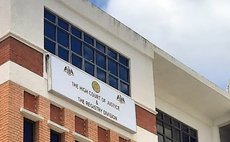"The Roseau Valley would be a nightmare"
Like in St. Vincent recently, if a volcano erupted in Dominica…
The mere thought of it is as horrifying as the most frightening of nightmares.
"Were we to have a volcanic event in Dominica - and the most likely place for it is [the Roseau Valley] - we wouldn't have a chance," warns Athie Martin, the environmentalist.
"We would not. have. a. chance," he repeats for emphasis.
With St. Vincent and the Grenadines rocked by the explosive eruption of the La Soufriere volcano - displacing about 20,000 people, according to the authorities in Kingstown – thoughts have turned to how Dominica would handle a similar volcanic event.
"God only knows what would happen," opines Severin McKenzie, an experienced architect and holder of a diploma in disaster risk reduction at the community level. Both Martin and McKenzie, as well as Edison James, the former prime minister, spoke to The Sun about their concerns over a lack of preparedness for a volcanic eruption here. While the country continues to focus on hurricanes due to the frequency of these storms and the large-scale destruction they cause, there's little evidence to suggest that much thought is being given to preparing for volcanic eruptions.
Since the formation of the island, there've been only two recorded volcanic activities – both were steam explosions in the Valley of Desolation in 1880 and 1997. And you'll have to go back 600 years for evidence of any activity involving lava, from Morne Patates, a dome within the Plat Pays volcanic complex, according to a European Union (EU) report on volcanic hazards in Dominica.
However, seismologists agree that there are nine active volcanoes here – more than any other country in the Eastern Caribbean – which are likely to erupt. They're located mostly in the Roseau Valley, as well as in Soufriere/Scotts at Morne Patates, Morne Plat Pays, Morne Anglais, Grande Soufriere, Morne Watt, Micotrin, Morne Trois Pitons, and Morne Diablotin, and, in the extreme north, Morne Au Diables.
According to the EU report on an exercise conducted in May 2015 as part of the project VUELCO – Volcanic Unrest in Europe and Latin America: Phenomenology, Eruption Precursors, Hazard Forecast and Risk Mitigation, the most likely type of eruption is a phreatic (steam) one from the explosion craters of the Valley of Desolation.
"Such an eruption is expected to be relatively small and to only affect the area directly surrounding the vent," says the report.
The most likely scenario for a magmatic eruption, it adds, is a dome-forming eruption from within the Plat Pays volcanic complex, which " will probably generate dome-collapse pyroclastic flows, pyroclastic surges and lapilli [rock fragments ejected from the volcano] and ash falls", with the dome-forming eruption likely continuing for "many years and would affect large areas of southern Dominica."
The most devastating, yet least likely scenario is an eruption dominated by hot gas and ash from Wotten Waven, where "pyroclastic surges resulting from the collapse of a Plinian column would affect most of the island except for the far north." While volcanoes remain a "constant and present danger," according to James, there appears to be no national volcanic contingency plan to guide action in the event of an eruption.
The last volcanic emergency simulation exercise, Operation Lava Flow, took place in the late 1990s when James was prime minister, recalls McKenzie. While this could not be immediately confirmed, James recalls that exercise, which involved the communities of Soufriere, Scotts Head and Pointe Michel and the erection of a floating jetty to facilitate the evacuation of residents.
"There has to be strong emphasis on preparation, understanding how these things happen, paying attention to the science, and preparation. So, to the extent there has not been any major similar simulation exercises for this long suggest there's a big gap there that needs to be filled," advises the former prime minister, who served from 1995 to 2000.
A volcanic contingency plan was first drafted in 1999 and revised in September 2006, December 2009 and February 2010. However, 22 years later, it remains a draft, with the latest version dated April 2015, according to the EU report, which quotes the 2015 "Draft National Volcanic Contingency Plan for Dominica" by Robert B Watts.
The stated objectives of the plan are to prevent loss of life, the safe relocation of populations in danger, inform and direct the relevant agencies and educate the general public. It contains evacuation plans for each of the key geographical areas of the country, with the possible displacement of approximately 43,500 people.
"An evacuation of the area without at least six hours' notice before a major event would prove difficult," states the 2010 draft, a copy of which was obtained by The Sun. The plan also assumes that funding will be made available through an annual budgetary allocation or through a contingency fund warrant, none of which has happened.
The authorities in St. Vincent have discovered that immediate evacuation was "somewhat chaotic", but largely successful, with conditions in the shelters being "very uneven" and some less than adequate, according to Camillo Gonsalves, the finance and economic planning minister.
"We were probably two weeks too slow in acquiring additional cots, so a few thousand cots are still in Miami awaiting clearance to fly down - ash has closed airspace - as such, many people are sleeping on the floor," says Gonsalves.
According to Martin, "we would have a disaster five times worse" due to the absence of a proper plan for volcanoes. He refers to increasing construction in the red zone, mostly the Roseau Valley, which includes the capital.
"If this were Dominica . . . we would have a mega disaster on our hands. We don't have an evacuation plan for the people of Laudat, Trafalgar, Louisville, Bath Estate. Where do those people go if ash and lava start pouring down the Roseau Valley? Where do they go?"
The draft volcanic plan acknowledges the vulnerability of the various communities at risk because of the single, narrow roads in and out. It also anticipates that people may not be able to return to their communities for years, maybe decades.
This is why proper planning is essential, says James.
"We probably need to have ourselves equipped with whatever is needed – have constant information of the numbers in the red zone who are likely to be evacuated. The shelters that will be needed, they must be in a state of preparedness, not only in terms of physical structure but what is in those structures and the personnel to manage those operations," stresses the former leader.
"The road network in the two most vulnerable areas, which are Soufriere with Morne Plat Pays, and those volcanoes in the Roseau Valley, in both areas it's cul-de-sacs you have," adds McKenzie. "The Roseau Valley would be a nightmare."




